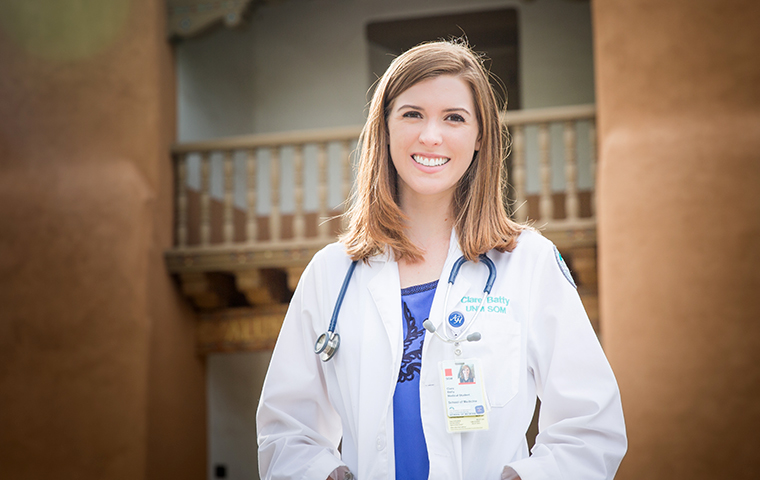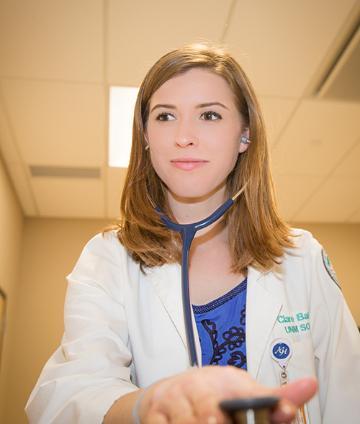
‘Chaplain Clare’ Offers Patients Both Spiritual and Diagnostic Care
Before heading to medical school, Clare Batty ’14 turned to chaplaincy to strengthen her connection to patients.
As a third-year medical school student, Clare Batty ’14, public health science/Spanish studies, has prayed at the bedside of dying patients who had no loved ones nearby to comfort them. She has consoled those who have just learned of their terminal disease. She has offered the solace of a Bible passage to the parents of a stillborn baby, then privately wept afterwards over the tragedy.
Batty has done all of these things not as student learning to be a doctor, but as a trained chaplain providing hospital patients with spiritual care. It’s not an easy skill to embrace, and one few young people learn.
Yet the former pastoral ministry staffer at SCU said she approached her work from the Jesuit tradition she valued.
“I just think that all medical providers should stretch their capacity for empathy,’’ Batty said, “and treat the whole person–body, spirit, and mind.’’
The experience set her on a delicate path most doctors must learn to navigate, though in her case, earlier than most: how to support patients facing health crises or end of life, and counsel their loved ones.
Filling a Growing Need
For Batty, it all began just a few months after graduating from Santa Clara University–and a year before starting her medical studies at the University of New Mexico–when she applied to a novel hospital chaplaincy program that trains lay people to become part-time spiritual caregivers for patients of all faiths—or no faith at all.
While priests, rabbis and other clergy regularly provide these services to patients, hospitals largely depend on chaplains. And their value is growing: according to the American Hospital Association, 70 percent of 4,862 U.S. hospitals surveyed in 2015 provided pastoral care services, up from 53 percent in 2002.
Not surprisingly, studies show many patients report that religion was the most important factor that helped them cope with their illness or hospitalization.
Still, the organizers of the chaplaincy program at Presbyterian Hospital in her hometown of Albuquerque never anticipated an application from a 22-year-old.
Her tiny inaugural class of four adults—ages 33 to 55—included a Catholic deacon, a Christian minister, and a former technology worker.
Could a well-meaning young woman on the cusp of adulthood conjure the strength and wisdom to guide others through some of their darkest times?
Program director Jeffrey Hoppe, who received his Masters of Divinity from the former Golden Gate Baptist Theological Seminary, pondered the same question.
“I was not ready for clinical pastoral education at age 22,’’ he recalled. “I know very few people who are ready for CPE at 22.’’
Taking a Chance
But the more he talked to Batty, the more he reconsidered.
It helped that she was the daughter of doctors, and had grown up listening to their discussions about work and difficult cases; she was also familiar with hospital settings, where she had visited her parents over the years. Her pastoral ministry mentoring at Santa Clara was a plus, as was her SCU work with a San Jose nonprofit focused on helping homeless adults, whom she met with weekly.
“I knew that she was serious about matters of faith, and that made a big difference for me in terms of taking a chance,’’ Hoppe said. (Batty’s younger brother, Luke, is in his third year at SCU School of Law.)

Though it was her mother who had brought the program to her attention, Hoppe was impressed that a 22-year-old was pushing to pursue it.
“Truth be told, as a mentor and supervisor, she’s a totally different generation from me. And I thought, ‘Wow. This is an opportunity for me to learn from her,’” said Hoppe.
Batty was in. Every week for five months, her group would meet with the veteran chaplain, who guided them in the art and practice of his profession.
Each student would receive one unit of credit, equivalent to 400 hours of ministry comprised of 100 hours in class, and 300 clinical hours with patients and families in the hospital.
Rules of the Spiritual Road
Their syllabus listed rules on the basics of chaplaincy, from never pressuring anyone into a visit; to never sitting on a patient’s bed; and never, ever telling relatives that a loved one “has gone to a better place.’’
Course reading lists included books on how to “listen in a healing way,” and “being present’’ with patients.
For those patients who wanted someone to talk to, chaplains emphasize open-ended questions: “What gives meaning to your life? How do you find your inner strength? What could the chaplain do to help?”
And each Monday, importantly, the ministry students had to discuss their own written accounts of interactions with hospital clients during the week. Talking about the high and low points, Hoppe said, would help them build self-awareness of their emotions.
“We had to write about our reflections–something that was scary or challenging,” recalled Batty. Still, she worried about how people perceived her.
“I remember walking into a room and introducing myself as ‘Chaplain Clare,’ and the look of surprise on their faces,’’ Batty said. “I think they were expecting to see a nun or a priest.”
Tougher individuals grilled her: Did she have any children? How could she know what it was like to lose a child? Batty could not give them the answer they wanted, but could, she told them, empathize with their unfathomable pain.
Hearing the Heartache
Heartbreaking tales called from the rooms of suffering, lonely patients, to the elderly woman–a member of Batty’s own Catholic parish–whose beloved husband had died on the way to the hospital emergency room.
But it was early on in her training when she encountered a stillborn baby, and it shook her deeply.
“I had never seen a young life pass away before my eyes,’’ said Batty, who recalled how the bereft parents asked her to pray with them and bless their tiny one. With her pocket Bible in hand, Batty gently read a passage, either Psalm 23: “The Lord is my Shepherd…” or Matthew 11:28-30: “Come to me all you that are weary and are carrying heavy burdens…’’ She cannot remember which one.
Hours later, she tearfully sought out Hoppe for his insights.
Her mentor counseled her that part of being a chaplain is learning to deal with one’s own grief and sadness, and coming to terms with the fact that life is not fair.
Gaining Confidence over Time
In instances like these, Batty said, she struggled. By the time the class ended in mid-March 2015, she was more self-assured.
“I figured out the right way to read people,’’ she said.
“Do I help them? I hope so,” said the now 26-year-old. “It felt like it when we would pray together, and I would let them know that their loved one would be care for in the next life. They expressed their gratitude.”
Batty continued working as a part-time chaplain once a month until this spring, when the demands of medical school became too great.
Some of her classmates there know about her spiritual work—a few even good-naturedly call her “Minister Doctor Batty.” But they also acknowledge that she is able to offer patients both spiritual and diagnostic care at once.
In the end, Batty said, being a part-time chaplain gave her an opportunity to work with people from different backgrounds who were going through incredibly difficult, life-changing experiences. And they opened up a little part of their lives for a young woman to come in and offer compassion.
“I learned that it’s important to address the patient as a person,’’ she said, “and not just look at them as the condition or diagnosis they have.’’